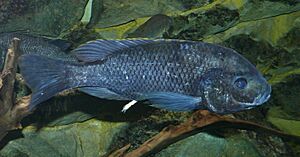Oreochromis squamipinnis facts for kids
Quick facts for kids Oreochromis squamipinnis |
|
|---|---|
 |
|
| Adult male. | |
| Conservation status | |
| Scientific classification | |
| Synonyms | |
|
The Oreochromis squamipinnis is a type of cichlid fish. It is also known as the chambo fish. This fish is only found in a few lakes and rivers in East Africa. These include Lake Malawi, Lake Malombe, and the Shire River.
Sadly, this fish is now critically endangered. This means it is very close to disappearing forever. It is important for local fishing and is sometimes kept in aquariums. However, too much fishing, called overfishing, has caused its numbers to drop a lot.
Contents
What the Chambo Fish Looks Like
This fish can grow up to 36 cm (14 in) long. That's about the length of a school ruler!
Young chambo fish and female chambo fish look a lot like two other types of fish. These are O. karongae and O. lidole.
However, adult male O. squamipinnis are different. They have pale, light-colored heads. This helps tell them apart from the males of the other two species.
Where the Chambo Fish Lives
The Oreochromis squamipinnis lives in many different places within its home lakes and rivers. It especially likes to live in shallow water. This is where it can find its food and stay safe.
What the Chambo Fish Eats
The O. squamipinnis is part of a group of fish called Nyasalapia. These are all known as chambo fish.
This fish mainly eats tiny green plants floating in the water. These plants are called phytoplankton. It also eats tiny animals called zooplankton. Sometimes, it will eat detritus, which is decaying plant and animal matter.
A Tricky Mimic Fish
There is another cichlid fish called Corematodus shiranus. This fish is very clever. It is an aggressive mimic of the chambo fish. This means it looks and swims just like the chambo.
Because it looks so similar, Corematodus shiranus can swim close to groups of O. squamipinnis. The chambo fish don't suspect anything. Then, the mimic fish quickly takes a bite of their scales or fins! This is how it gets its food.


